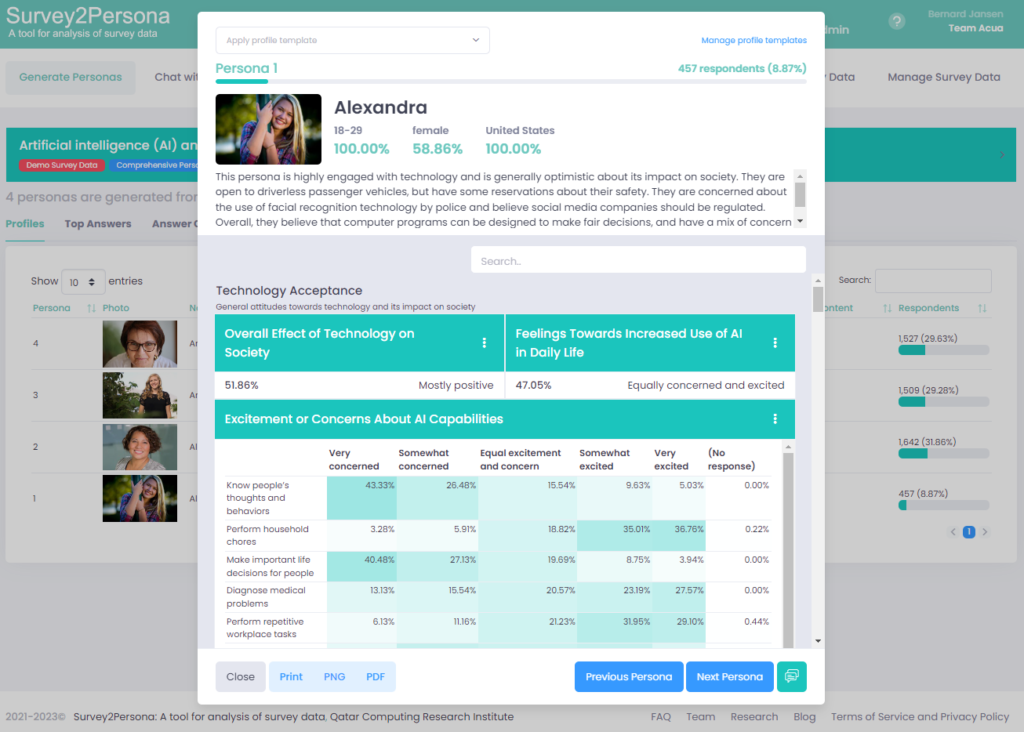
Algorithmically generated personas have emerged as quintessential tools for understanding audiences, customers, and users, bridging data analytics and human-centric experiences. These algorithmically-generated personas (APGs) are at the intersection of user experience research, marketing strategies, and product development, and APGs are realistically crafted identities that mirror the varied facets of a target audience, customer, or user segment. Our Acua system generates personas using large amounts of analytics data, and our Survey2Persona system generates personas from survey data.
However, a critical question in the creation process is: what information should be included in a persona profile to transform the numbers and data into relatable narratives?
The answer to this question is bounded by how the APG will be used. It’s paramount to understand that the persona’s purpose anchors the part of the persona profile. Are we designing these personas for marketing endeavors, software development, or educational purposes? The intended application not only guides the selection of information but also the depth and relatability required of the parts of the persona profile. For instance, a persona for a social media campaign might delve deeper into psychographics, while one for educational content may prioritize learning behaviors and academic inclinations.
With that context, here are some typical parts of the persona profile to consider.
Demographics: This is the foundational part of the persona profile. Demographics form the skeletal framework of a persona. This includes age, location, occupation, and educational background, providing a categorical view that aligns with broader target market segments. While demographics offer a starting point, they do not flesh out the key aspects of the persona. While some personas designers advocate not having demographics, we have found demographics are expected by persona users, offer persona used that human aspect of empathy for the persona, and are valued in look-alike analytics for the cold start problem.
Psychographics: This is a key humanizing aspect of the persona profile. Psychographics imbue the persona profile with personality, values, opinions, attitudes, interests, and lifestyles. If demographics show “who” the persona is, psychographics reveals “why” they make certain choices. Psychographic information is pivotal in creating empathy for the persona’s problem and understanding user motivation, providing a richer context for interaction strategies. For instance, knowing a persona is motivated by environmental conservation can shape the narrative used to engage the persona, perhaps through eco-friendly narratives or sustainable practices.
Behavioral Data: While psychographics explain motivations, behavioral data showcases the persona’s actions. What are their browsing habits? Buying behaviors? Preferred digital platforms? This attribute illuminates the path of interaction with the product or platform, offering tangible touchpoints for audience, customer, or user engagement. Behavioral data is about recognizing patterns and utilizing these past patterns to predict future interactions, enhancing the persona experience by anticipating needs and preferences.
Contextual Information: The persona does not exist in a vacuum. Contextual information relates to the environment in which the persona operates, including physical, technological, and social aspects. Contextual information answers questions about where, when, and how the persona interacts within its ecosystem, influencing the design of or the marketing of products and services, such as user interfaces, product features, and communication methods. For instance, understanding that the persona often browses eco-friendly products on a mobile during a commute to work highlights critical elements about the environment and tech usage.
Narrative: Finally, the persona profile culminates in a narrative—a story that makes the persona relatable, tangible, and empathetic. This narrative ties the other informational elements into a coherent story, making the persona memorable and engaging. It is not about overloading the persona profiles with additional information but about presenting a clear, concise, and compelling story that resonates with real user challenges and aspirations.
In conclusion, the science of crafting an algorithmically generated persona lies in a balanced, insightful mix of demographics, psychographics, behavioral data, and contextual information, with all parts of the persona profile woven into a compelling narrative. Check out our blog post on questions for persona creation.
Read some of our research articles on the development of personas and specifically algorithmically generated personas.
Guan, K., Salminen, J. Jung, S.G., and Jansen, B. J. (2023) Leveraging Personas for Social Impact: A Review of Their Applications to Social Good in Design. International Journal of Human-Computer Interaction. DOI: 10.1080/10447318.2023.2247568
Salminen, J., Santos, J., Jung, S.G., and Jansen, B. J. (2023) How Does an Imaginary Persona’s Attractiveness Affect Designers’ Perceptions and IT Solutions? An Experimental Study on Users’ Remote Working Needs. Information Technology and People. 36( 8), p. 196-225. https://doi.org/10.1108/ITP-09-2022-0729
Salminen, J., Mustak, M., Sufyan, M., and Jansen, B. J. (2023) How can algorithms help in segmenting users and customers? A systematic review and research agenda for algorithmic customer segmentation. Journal of Marketing Analytics. https://doi.org/10.1057/s41270-023-00235-5
Kaate, I., Salminen, J., Santos, J., Olkkonen, R., Jung, S.G., and Jansen, B. J. (2023) The Realness of Fakes: Primary Evidence of the Effect of Deepfake Personas on User Perceptions in a Design Task. International Journal of Human Computer Studies. 178, Article 103096.
Jansen, B. J., Jung, S.G., and Salminen, J. (2023) Finetuning Analytics Information Systems for a Better Understanding of Users: Evidence of Personification Bias on Multiple Digital Channels, Information Systems Frontiers. https://doi.org/10.1007/s10796-023-10395-5
